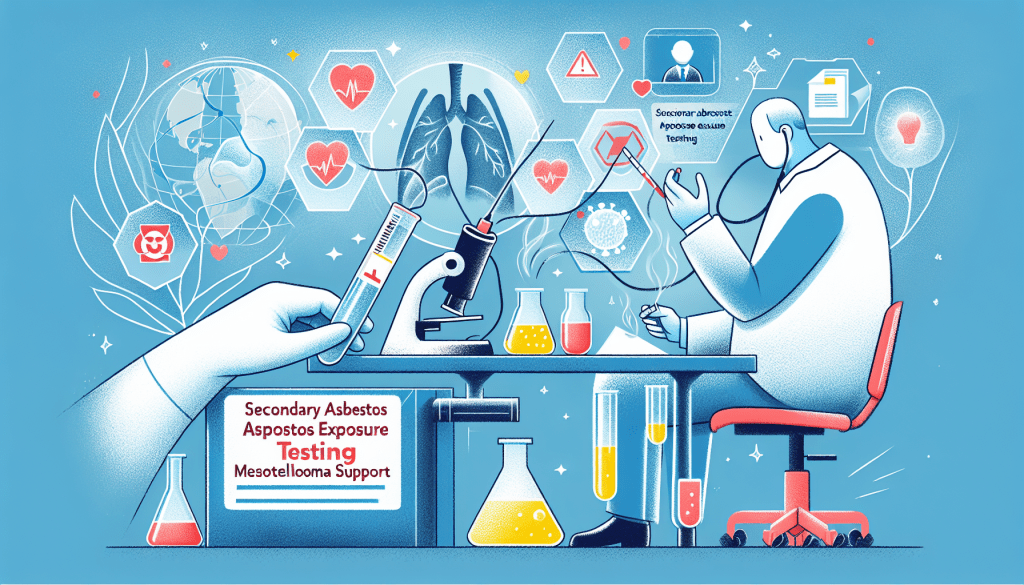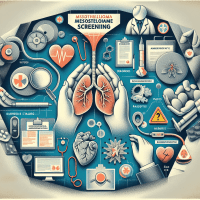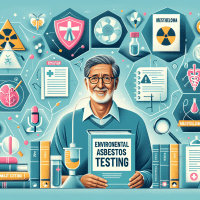Secondary Asbestos Exposure Testing: Mesothelioma Support
Hello, I’m a registered nurse with over 10 years of experience in oncology, and I understand firsthand the deep emotional and physical challenges that come with a Mesothelioma diagnosis. I created this guide to share compassionate, practical insights about secondary asbestos exposure testing and offer you a trusted companion in your journey. When it comes to Mesothelioma cancer, every piece of information matters, especially when it helps to foster hope and clarity for you and your loved ones.

Understanding Mesothelioma and Secondary Asbestos Exposure
Mesothelioma is a rare and aggressive cancer, most commonly linked to asbestos exposure. But even less direct exposure, such as secondary asbestos exposure – for instance, when household members come into contact with residues brought home by workers – can increase risk. In this guide, I delve into secondary asbestos exposure testing to help you better understand what it means for diagnosis and treatment planning.

A visual reminder that you are not alone in this journey.
The Role of Secondary Asbestos Exposure Testing
When discussing secondary asbestos exposure testing, it’s important to note that these tests are generally used to evaluate whether someone who has had indirect exposure might be at risk. The process involves assessing a person’s history, potential exposure situations, and, when necessary, conducting specialized tests. Whether you’re a household member of an asbestos worker or concerned about environmental exposure, understanding the testing process can alleviate some anxiety surrounding the unknown factors of Mesothelioma diagnosis.
What Does the Testing Involve?
Secondary asbestos testing is not a standalone diagnostic tool for Mesothelioma. Instead, it’s part of a comprehensive evaluation that includes medical imaging, biopsies, and professional assessments. Here’s a brief overview:
- Medical History and Exposure Evaluation: A detailed discussion of your exposure, including potential sources of secondary asbestos, forms the backbone of the assessment.
- Imaging Tests: Techniques like X-rays and CT scans help visualize any asbestos-induced changes in the chest cavity and pleura.
- Biopsies: Procedures such as thoracoscopy or thoracentesis are conducted to obtain tissue samples. These steps are crucial in confirming a diagnosis.
This testing is especially important for those who have experienced even non-occupational exposure, such as secondary asbestos testing for household members or asbestos testing for family members of asbestos workers.
Diagnosis, Staging, and Treatment Options
Diagnosis of Mesothelioma typically follows a pattern. Once symptoms are evident and testing suggests potential exposure, a series of diagnostic tests help establish the presence and extent of the disease.
Understanding Different Biopsy Procedures
Biopsies such as thoracoscopy and thoracentesis provide the essential tissue samples needed to confirm a diagnosis. They are minimally invasive procedures performed with careful monitoring. I always emphasize to my patients that while these procedures can feel daunting, they are critical for determining the best course of treatment.
Decoding the Mesothelioma Staging System
Once diagnosed, understanding the stage of Mesothelioma is key. The staging system generally ranges from Stage 1 to Stage 4:
- Stage 1: Cancer is localized and may be treated with surgery, chemotherapy, or radiation.
- Stage 2: The cancer shows limited spread. Integrated treatment approaches are usually recommended.
- Stage 3: Cancer has spread more, often involving multiple treatment modalities to manage symptoms and improve quality of life.
- Stage 4: Advanced stage where treatment focuses on symptomatic relief and palliative care.
For those navigating a diagnosis, understanding each stage can help in setting realistic expectations and tailoring care to your comfort and safety.
Emotional Support and Coping Mechanisms
No journey through Mesothelioma is only medical; it’s deeply emotional. Having faced these challenges with many patients, I have learned that managing emotional well-being is as crucial as medical treatment.
Navigating Anxiety, Fear, and Grief
Each diagnosis brings a whirlwind of emotions. Whether it is anxiety about the future or grief over a sudden change, it’s important to acknowledge these feelings. I encourage open conversations with family, seeking mental health counseling, and joining support groups where shared experiences pave the way for healing. Techniques such as mindfulness exercises, regular physical activities, and spiritual practices have also proven beneficial.
The Importance of Communication with Loved Ones
Discussing your feelings and concerns openly with loved ones can strengthen support systems. In one instance, I remember a family who used regular check-ins to discuss each member’s feelings, which proved to be a compassionate way to collectively manage stress and fear. Such personal reflections remind us that nurturing relationships is as vital as any treatment plan.

Diagram illustrating treatment paths and hope for recovery.
Practical Guidelines for Moving Forward
At this point, you may be wondering about actionable next steps. I encourage you to:
- Consult Healthcare Professionals: Use secondary asbestos exposure testing results as a starting point for deeper investigations with specialists.
- Seek Emotional Support: Consider counseling or support groups. Resources like the Mesothelioma Applied Research Foundation can offer both factual and emotional support.
- Stay Informed: Regularly consult reputable sources such as the National Cancer Institute or American Cancer Society to understand evolving treatment guidelines. (Information on treatment guidelines current as of May 2025)
A Personal Reflection
From my own experience working with patients facing Mesothelioma, I have seen how important it is to receive honest, compassionate guidance. Remember, while the path may be challenging, you are not walking it alone. Every step, every test, and every consultation is part of a journey toward empowerment and hope.
Understanding the Testing Process for Indirect Exposure
Many families find themselves concerned about secondary asbestos exposure without knowing where to begin. Whether you are seeking secondary asbestos testing, or wondering about asbestos testing for non-occupational exposure, detailed assessments help in developing an overall health strategy. Testing services near you, such as local centers that specialize in environmental exposure, are equipped to provide both diagnostic clarity and reassurance.
Integrating Internal Resources for Support
I invite you to explore additional resources on this site. For instance, check out our articles on Mesothelioma Treatment Options and Caregiver Support Resources to gain further insights and community advice.
Detailed Guide: Managing Your Doctor Visits
Here is a practical checklist that you can use the next time you visit your doctor:
- Prepare Your Questions: Write down any concerns, including inquiries about secondary asbestos exposure and how it might affect your overall risk.
- List Your Symptoms: Clearly detail any changes or new symptoms, however minor they may seem.
- Document Your Exposure History: Include any indirect exposures, such as household contact with asbestos workers.
- Discuss Next Steps: Make sure you understand the timeline for any further tests or treatments suggested by your healthcare team.
Mindfulness and Guided Relaxation
In moments when anxiety overwhelms you, I recommend a few simple mindfulness exercises. Sit in a quiet room, focus on slow breathing, and repeat a calming phrase to yourself. This technique, rooted in mindfulness practices, can help center your awareness and provide emotional relief. Combining these practices with professional support can markedly improve your quality of life.
Final Thoughts: A Journey of Hope and Shared Strength
Every aspect of this journey, from secondary asbestos exposure testing to coping with a Mesothelioma diagnosis, requires both factual understanding and heartfelt support. I hope this guide has not only provided you with practical steps but also offered a sense of solidarity and compassion. Remember, reaching out to trusted healthcare professionals and support networks can make a significant difference in your experience.
Words of Encouragement I’ve Found Helpful
Please know that while this battle is difficult, the strength you show every day is inspiring. I stand with you as you navigate these challenging times, and I encourage you to lean on your loved ones and community for unwavering support.
If you have any questions or need further guidance, I urge you to consult with healthcare professionals who understand your unique situation. The path ahead may be unpredictable, but together we find power in shared resilience and hope.
Disclaimer: This information is provided from my experience as an oncology nurse and is meant to supplement, not replace, professional medical advice. Always consult with your healthcare provider before making any health-related decisions.






